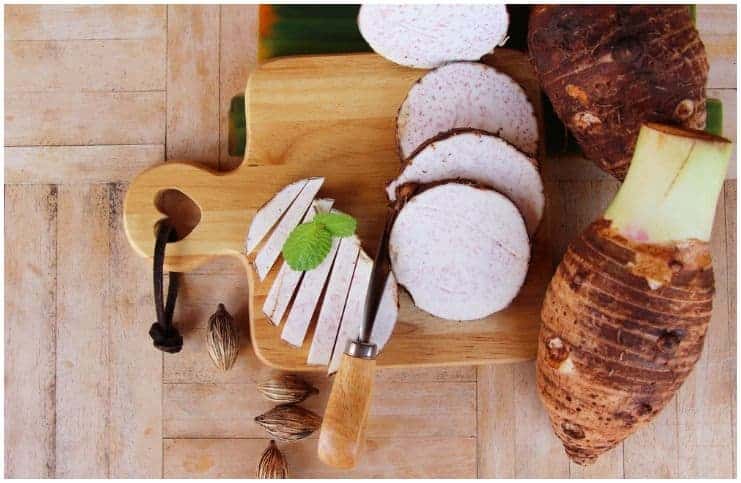Taro Root: Health Benefits and Side Effects:
Taro root is a popular starchy edible root in large parts of the Pacific Islands, Asia, West Africa, and Amazonian regions of South America.
In the Solomon Islands, archaeological studies indicate the usage of taro root as early as 28,000 years ago.
It has a global culinary presence, though. Over 10 percent of the world’s population uses it as a food staple.
This plant was extremely important to the Hawaiians, who associated it with their Gods and their story of creation, using it for medicinal purposes, and it is even the theme of an annual food festival.
It is a perennial, tropical plant mainly grown as a root vegetable for its edible starchy corm, and as a leaf vegetable.
The leaves are one to two meters long with a long, erect petiole and an arrow-shaped blade. Plants like this are sometimes called “elephant ears.”
It has been named „the potato of the humid tropics.” Although it’s a bit higher in calories than a potato, it has more of the essential nutrients to make up for the extra digits.
Nutrition Facts
It contains vitamins A, B2, B3, B6, C, E, and K, and minerals which include calcium, magnesium, iron, selenium, zinc, phosphorous, potassium, manganese, and copper. The plant also provides protein (3%) and dietary fiber (10%).
The roots and leaves can be used as dietary ingredients, but the plant must be cooked. Raw leaves are toxic, however, and must be cooked or soaked for several hours before safely consuming.
Uses and health benefits of taro root
Digestion
This plant contains a good amount of dietary fiber that is beneficial for the digestive process.
This gives you a feeling of being full for a longer time, even after a small meal. In addition, dietary fiber increases the size and weight of your stool and softens it.
A bulky stool is easier to pass, lowering your chance of constipation. If you have a loose, watery stool, dietary fiber may help to solidify the stool because it absorbs water and adds bulk to it.
Another really important role of it is that some fibers are prebiotics, which means they are fermented in the colon by the healthful beneficial bacteria.
Low glycemic index food
The root is a low glycemic index food. This means it breaks down into glucose in the liver very slowly, hence making it great for lowering blood sugar too, which means that it does not cause blood sugar levels to spike after consumption.
Healthy heart
It has a low percentage of fat and no bad cholesterol (LDL), thus it promotes the heart’s health by preventing the hardening of arteries.
Antioxidants that block the oxidative modification of LDL have been shown to slow the progression of atherosclerosis in animal studies. Moreover, the antioxidants keep cholesterol from going through a process called “oxidation.”
Oxidation happens when oxygen reacts with cholesterol in your blood. Furthermore, this also provides a number of important minerals such as magnesium, zinc, copper, iron, and manganese, all essential nutrients for cardiovascular health.
Anti-aging
Certain vitamins have anti-aging qualities that improve not only your appearance but also your health in a number of ways.
The rich content of different beneficial acids, vitamins, enzymes, and antioxidants, inorganic minerals like iron, zinc, and copper in taro root helps lower the sign of premature aging and remove free radicals.
Good for athletes
The root contains 20% carbohydrates, which are the fuel that makes the body’s engine run, and athletes need enough carbohydrates before, during, and after exercise.
The body generates energy from carbohydrates much more rapidly than it does from fat, and the central nervous system and brain rely exclusively on carbohydrates for fuel.
Athletes who train hard know that they need to properly fuel up before starting out in order to keep the good carbs coming in during activity and to refuel properly afterward.
Laxative
The leaf juice is used to treat piles and as a laxative in some traditional medicine systems, while in Hawaii, poi (starchy Polynesian food paste made from the taro root) is mixed with arrowroot for diarrhea.
Skin and hair
The antioxidant vitamins A, C, and E levels also ensure glowing and healthier skin and mucous membranes, prevention of premature skin wrinkling and aging, faster healing of wounds, better hair health, hair loss, and reduction of dandruff.
Precaution and side effects
This root contains calcium oxalates in the form of needle-shaped crystals. This produces irritation and a burning sensation if the vegetable is handled or eaten raw.
Therefore, the use of gloves is sometimes suggested when preparing it, and long cooking is necessary to destroy these harmful substances.
READ THIS NEXT:
Schizandra Berry Tea – Side Effects & Health Benefits
References https://www.ncbi.nlm.nih.gov/pmc/articles/PMC3550941/ https://www.sciencedirect.com/science/article/pii/S1756464615003722 https://www.aaccnet.org/publications/cc/backissues/1992/documents/69_528.pdf
